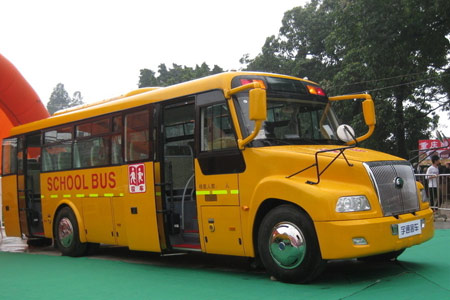New school buses ensure students' safety
 0 Comment(s)
0 Comment(s) Print
Print E-mail Xinhua, February 9, 2012
E-mail Xinhua, February 9, 2012
On the first day of the new semester, thousands of students in Chongming county in Shanghai rode the brand-new school buses to school.
 |
|
The new school bus in China. |
The new school buses are yellow with huge bonnets in the front. Students call them "big nose" school buses.
The local government invested 6 million yuan (953,000 U.S. dollars) to buy 17 new school buses for the primary and middle schools in the county to ensure the safety of more than 1,000 students who live in rural areas, where ordinary buses couldn't easily access.
This kind of school bus, equipped with alarms, on-board cameras and seats specially designated for schoolchildren, are much safer than minivans or older buses that were used in this county before.
"'Big nose' looks very beautiful, and it makes me feel safe," said Liu Mengqing, a four-year student of Xinhai School.
Liu said that in the old school buses, there was no air conditioner and every two or three children shared one seat in the past.
"The new buses are sturdy enough so that parents shouldn't be worried about their children," said Zhang Zhongli, a father of a student, adding that the bus fee is only 300 yuan (48 U.S. dollars) each month, almost the same as before.
According to the local educational authorities, schools in Chongming county will provide student name lists and dispatch a "follower" who will check the number of students and contact parents before each bus sets off.
The authorities said that drivers of the new school buses have been strictly required to have at least three years of driving experience and a100,000-kilometer safe driving record. Drivers will also sign security commitments with schools.
At the beginning of the new semester, students in many parts of the country have taken the "big nose" school buses.
The government of eastern Tianchang City, Anhui province, spent more than 21.6 million yuan purchasing 90 school buses for students who live in remote, underdeveloped areas without access of public transportation.
In Jiangsu province, 100 new school buses were put into use on Monday for pupils of 32 rural primary schools in the Liuhe district of Nanjing, capital city of Jiangsu.
In 2011, a string of fatal school bus accidents occurred in China, raising public and government concern.
In December 2011, a school bus overturned and fell into a ditch Jiangsu province, killing 15.
Another 21 preschoolers were killed in a school bus accident that occurred in west Gansu province on Nov. 16, 2011. An investigation showed that 62 children were crammed in a nine-seat minivan when the accident happened.
"There are tremendous demands for safe school buses in the rural areas, but the economic development standards and the poor schools cannot meet the demands," said Zhang Jiadong, a public security expert at Fudan University.
Overloading buses is a common practice in China.
"In central and western China, relevant departments should pay close attention to the students' transportation security problems, while, supporting facilities and supervisory measures should be set up," said Liu Jinghai, headmaster of Xinba Middle School of the Zhabei district in Shanghai.
In early January, the National Technical Committee of Auto Standardization approved two mandatory safety standards for school buses.One standard stipulates technological safety requirements for school buses, while the other stipulates the size and quality of school bus seats.
China's safety watchdog said the nation will establish its school bus safety management system in the next four years.
All school buses must be installed with GPS systems by 2015, and every seat must be equipped with seat belt by 2013, in a bid to reduce the number of traffic accidents and fatalities.






Go to Forum >>0 Comment(s)